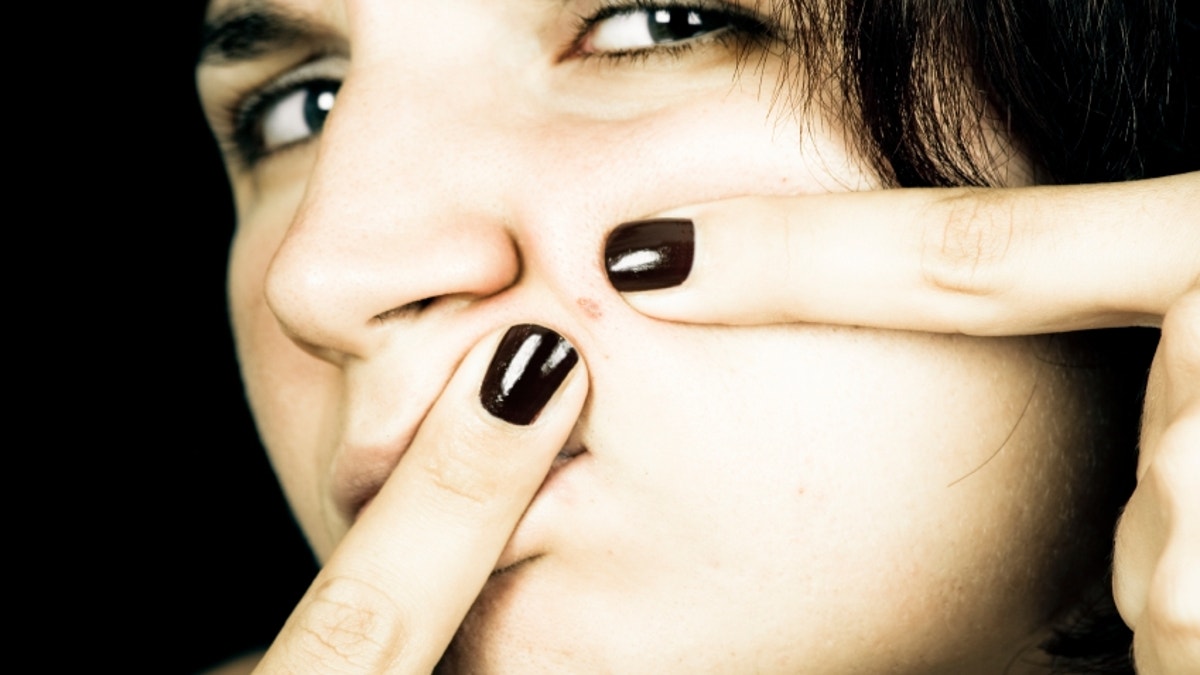
If you've ever had a pimple, you know how frustrating it can be to find a solution (and if you've never had a pimple, congratulations: you're the luckiest person alive). An overwhelming number of acne products are available (all making the same promise of clear skin), and yet, the harder you try to zap your zits, the more red and painful they can become. In order to truly banish blemishes, you'll need to distinguish the difference between the old wives' tales and tested truths. That's where we come in. Read on to learn how you can eliminate acne once and for all.
Health.com: 20 Things That Can Ruin Your Smile
Myth: Your diet has nothing to do with acne
"Two landmark but flawed studies conducted in the '60s and '70s found that chocolate was not associated with acne," said Jennifer Burris, doctorate candidate at New York University, and author of a Journal of the Academy of Nutrition review on diet and acne. "These studies were so popular that people concluded diet had nothing to do with acne and stopped researching the topic for the next 40 years."
Today, researchers are finding that there is indeed a connection between food and acne. Example: Burris and her team looked at the diets of more than 200 people and found that those who ate more sugary foods, dairy products, and unhealthy fats, as well as less fish, were more likely to have moderate to severe acne.
Health.com: 30 Healthy Foods That Could Wreck Your Diet
Myth: If you suffer from acne, you should never eat chocolate
Even though there's a connection between diet and acne, it's not exactly fair to throw chocolate under the bus.
"Essentially any food with a high glycemic index can increase blood cortisol levels and worsen acne," said Dr. Mona Gohara, associate clinical professor of dermatology at the Yale School of Medicine. (That includes sweets, breads, and pastas.) "Refined carbs cause your insulin levels to spike, which leads to increased sebum production and clogged pores."
The good news: You can still have chocolate! "The problem isn't the cocoa itself, it's the sugar and dairy that's added," said Dr. Marguerite Germain, a dermatologist in Charleston, SC, who suggested eating dark chocolate with a cocoa content 70 percent or higher. "The higher the percentage of cocoa, the lower the glycemic index."
Health.com: 13 Everyday Habits That Age You
Myth: Acne is a teenager problem
It's not a given that you'll grow out of acne. In fact, a survey of more than 1,000 adults published in the Journal of the American Academy of Dermatology found that 50percent of women between 20 and 29 years old, 35percent of women between 30 and 39 years old, and 26percent of women between 40 and 49 reported having acne. (Note: Adult acne is more common in women than men.) You can blame the same surge of hormones you experienced as a teen: "Your estrogen increases at your first period and peri-menopause," Gohara said. "The hormone causes an increase in oil production, which ultimately causes bacterial inflammation and pimples." That's why it's common for women to have acne as teenagers and again later in life.
Health.com: 21 Reasons Why You're Losing Your Hair
Myth: Makeup makes acne worse
It's true that some products can clog your pores and ultimately cause pimples, but the right makeup can actually improve acne. Dr. Gohara suggested powder-based mineral foundations with ingredients like silica, titanium dioxide, and zinc oxide.
"Powder foundations absorb oils that would otherwise be clogging your pores," she says. If you prefer a liquid foundation, make sure it's non-comedogenic. "That means the product hasn't been found to promote acne per the cosmetics company's standards," explained. Gohara.
Myth: Sunscreen clogs your pores
First, a little sunscreen 101. There are two categories of sunscreen: chemical sunscreens, which absorb UV light (common ingredients: oxybenzone and avobenzone) and physical sunscreens, which reflect UV rays (common ingredients: titanium dioxide and zinc oxide). While some chemical sunscreens can irritate the skin, causing inflammation and breakouts, physical sunscreens might actually help. "Zinc oxide, a common active ingredient in physical sunscreens, may kill acne-causing bacteria," Germain said. Look for the ingredient on your sunscreen label—no more SPF excuses!
Health.com: 15 Biggest Sunscreen Mistakes
Myth: Stronger products are better products
If you've spent more than 30 seconds looking at acne products in your drugstore, you know that benzoyl peroxide and salicylic acid rule the ingredient labels—and with good reason. The best acne treatments do two things: unclog pores and kill bacteria. These ingredients are often recommended because benzoyl peroxide blasts bacteria and salicylic acid unclogs your pores, tackling both problems.
Still, there's no need to go overboard, especially when it comes to benzoyl peroxide. A review published in Expert Opinion Pharmacotherapy found no difference between products that are 2.5 percent benzoyl peroxide and ones that are 10%—except that stronger products may be more irritating.
Myth: Toothpaste can heal a zit
"Toothpaste has baking soda, hydrogen peroxide, alcohol, menthol, essential oils, and triclosan, which, yes, can dry pimples out," Gohara said. "But it's not made for your skin, so it can cause irritation and rashes." This means you could essentially be trading one problem for another. Instead, try a spot treatment that contains benzoyl peroxide. It's made specifically for your skin—and won't leave your face smelling like spearmint.
16 Adult Acne Myths, Busted originally appeared on Health.com.
